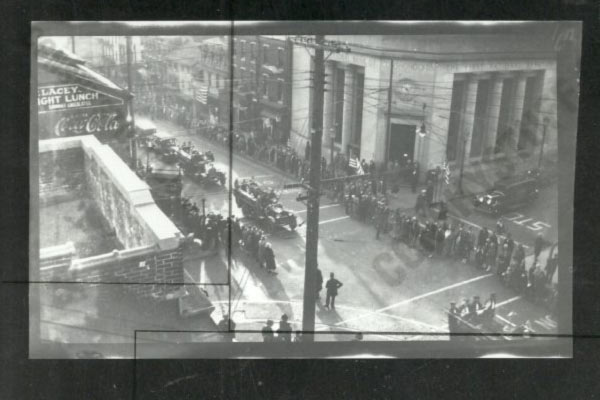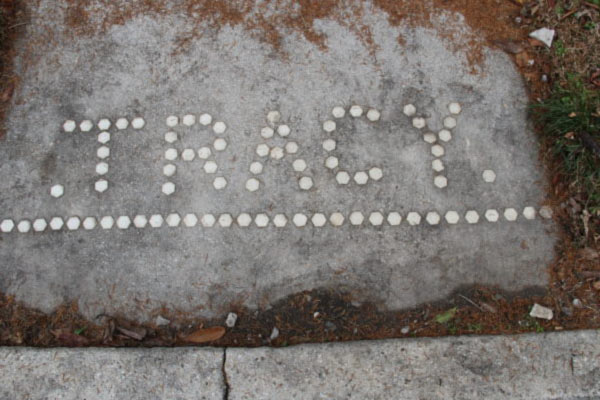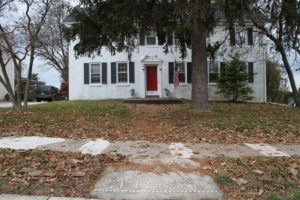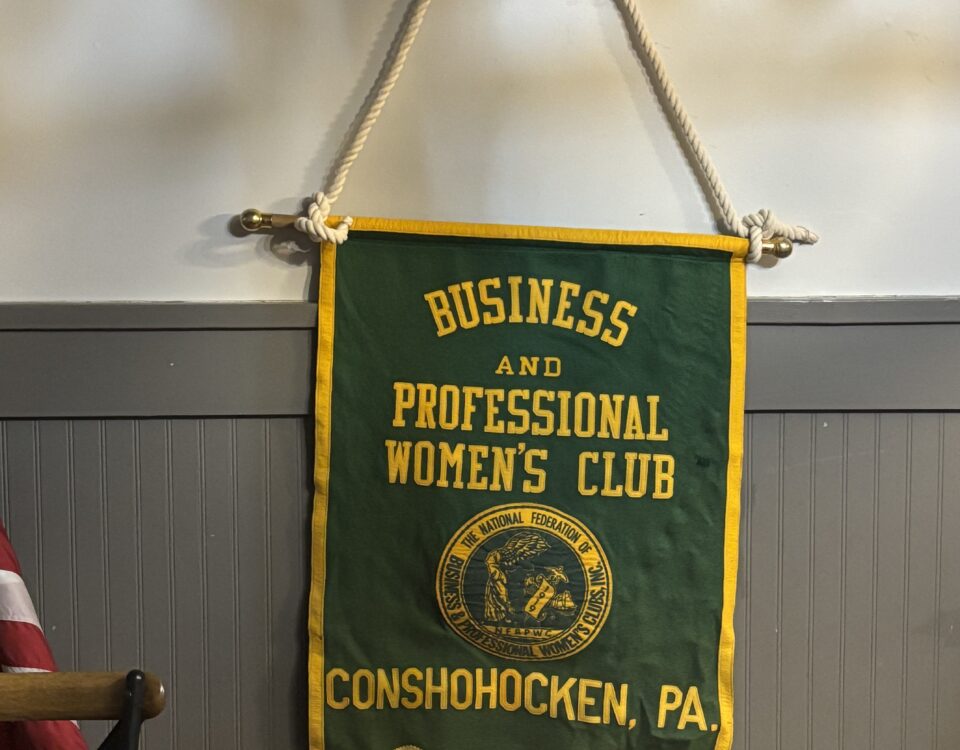
Conshohocken’s Biggest Parade – It Happened 100 Years Ago by Jack Coll
November 10, 2018
Hey, Do YOU Have a Thanksgiving Day Football Memory? Here are a Few For You.
November 24, 2018Conshohocken & West Conshohocken Neighborhoods, What Neighborhood do YOU Live In?

CONSHOHOCKEN & WEST CONSHOHOCKEN NEIGHBORHOODS
WHAT NEIGHBORHOOD DO YOU LIVE IN?
By Jack Coll

Tracy Terraces in front of 1410 Fayette Street, Conshohocken embedded in the concrete sidewalk.
There are few residents living today in Conshohocken or West Conshohocken that can recall the neighborhood they grew-up in. Many years ago residents were identified by the neighborhood they lived in and there were many neighborhoods within the two boroughs.
Neighborhoods were tagged by realtors with names to help enhance the development sales or identified for other reasons like ethnics or labeled for their location.
Today when Conshohocken residents meet someone from Conshy the question is, “Are you from the east side or west side?” In West Conshohocken typically the un-spoken question is, “Are you a “Newby” or “long-time resident?”
But in the old days when one borough resident greeted another they would ask, “What neighborhood are you from?” the answer would likely be “Maple Hills,” “Stemple’s Row” “Bullock Row” or one of a dozen other neighborhoods.
Naming the neighborhoods started more than a century ago. Long before some of our streets were named, there was the “Old Burn Bank” neighborhood once located along the canal bank in the area of Forrest Street and the canal. There was “The Bowery” once located along West Elm Street, “Frog Hollow” was the area that surrounded the old stone quarry along what was known as Colwell’s Lane and “Goat Hill” located in West Conshohocken near the cemetery. “Wilsontown” was also located on Upper Ford Street in West Conshohocken as was “Nobletts Row” still located on the 600 block of Ford Street.
I don’t think anyone today would remember “Banjo Hollow,” a small community once located in the area Fourth Avenue and Maple Street. It was called Banjo Hollow due to the many African Americans who had relocated from the South to work in Conshy’s steel mills. Legend has it that in the early evening, just after dinner as you walked along Maple Street there would be residents playing music from the deep South on a banjo on every other porch or stoop.
Down on lower Maple Street around the turn of last century was a neighborhood called “Cork Row.” Conshohocken’s first residents were primarily Irish. Moving to Conshohocken brought them work in the quarries, along the canal loading and unloading barges or in the steel mills. The first couple of blocks of Maple Street were built by the steel-companies and rent was always cheap along that stretch of Maple Street.
As the Irish secured better jobs and started moving uptown, members of the Italian community started to take-over lower Maple Street and expanded to Second, Third and Fourth Avenues, by the 1920’s that section of Conshohocken became known as “Little Italy.”
Colwell Lane was named after Stephen Colwell who had his iron and lime businesses throughout the Conshohocken-Plymouth area. Colwell conducted a portion of his business with the J. Wood & Sons Company. Colwell would smelt his iron into ingots and transport them along a dirt path that he cut through the woods on the lower west side of the borough. Because of the location of the trail, often Colwell’s horses and wagons were the only travelers to be found on the trail, a trail that became known as “Colwell’s Lane. The name never changed and even when the more modern highways pushed through the name remained “Colwell Lane.”
When prohibition went into effect on January 16, 1920, the lower end of Conshohocken turned into one-big still. Lower Maple Street, Elm Street and what seemed like all of Connaughtown were turning the polluted water of the Schuylkill River into some of the best liquor to be found on this side of the Mississippi River. On a Saturday night in Connaughtown there were more visitors than residents all buying “Moonshine” and “Sunshine.” The difference being “Moonshine” was typically made deep in the woods under the light of the “Moon” whereas “Sunshine” was made during the daylight hours, mainly by housewives, after their husbands went to work, they would mix a batch of “Shine” in the bathtub and bottle it before their husbands got home from work.
Colwell’s Lane in the 1920’s was still just a dirt path and the local residents who would transport the “Shine” would all travel undetected by the local police or federal agents along Colwell’s Lane that became known for several generations as “Whiskey Lane.” So often residents who lived in the area of lower West Fifth and Sixth Avenue lived in the neighborhood of “Whiskey Lane”
When they started to develop Upper Fayette Street around the turn of last century that section of the borough became known as “The Terraces.” A name that gave perspective buyers a feeling of living on top, “The Terraces,” the name projected an image for potential upper-class residents, then developers started to develop a large tract of the Tracy property along Upper Fayette Street in 1917 and sold the houses under the neighborhood nick-name “The Tracy Terraces.
By 1911 development started along Ninth, Tenth and Eleventh Avenues and the new development was called “Conshohocken Heights.” By 1920 a housing development on Eleventh Avenue between Wells and Jones Streets became known as “Leeland Heights.”
Alec Martin also constructed a number of Upper Fayette Street houses that were advertised for sale as “Martin’s Row.”
Then there is “Bullock Row” in West Conshohocken and Fulton Row in the Connaughtown section of Plymouth Township with a whole lot in common. Before we get to Bullock and Fulton Row we first have to go back to the Civil War. During the Civil War the United States government established the state’s mustering-out camp, or discharge camp for Civil War soldiers high above the west bank of the Schuylkill River, overlooking Conshohocken, in Lower Merion Township just outside West Conshohocken.
During the height of the Rebellion, many of the first enlistments time in the service was expiring. Under orders from the War Department dated October 14, 1864, a post was established here for the accommodation of troops sent to the state of Pennsylvania for discharge or reorganization. Soldiers belonging to troops of the Eastern States, many of them from Andersonville and other local areas, were sent to what became known as “Camp Discharge.”
Most of the arrivals at Camp Discharge were destitute, sick or miserable. Other soldiers arrived in good health and waited while their records and pay were being processed in anticipation of discharge or re-enlistment. Soldiers would not be discharged until they were declared in good health and properly clothed and provided for.
When the camp opened a large force of men leveled the rough, uneven surface of the ground and transformed it into a terraced plateau. Various buildings were constructed using lumber and material from the yards of Evan D. Jones on Hector Street and Norman Egbert of Soapston in Lower Merion. The rough boards were painted yellow, and the building included a post headquarters, hospital, quartermaster’s commissary department, three or four sets of barracks for the men, ice house, stables, guard house, engine house and sentry box.
The close of the war brought a speedy disbandment of the post. By orders from the war department, dated July 19, 1865, it was discontinued, and remaining personnel were transferred to Camp Cadwallader in what is now North Philadelphia.
The buildings and camp effects were sold at auction. George Bullock, unofficial “Father of West Conshohocken,” purchased half of the buildings and had them dismantled and reconstructed on Front Street overlooking the Schuylkill River in West Conshohocken and for many years were served as living quarters for his labors in his mills.
Samuel Fulton purchased the other half of the buildings and did the same thing. Fulton, who owned several foundries, reconstructed the buildings into row houses on what has become known as Fulton Street in the Connaughtown section of Plymouth Township. Since the late 1860’s the rows of houses built with the lumber from Camp Discharge have been known as Bullock’s Row and Fulton’s Row.
Howard Wood, Esq., later purchased all the property where Camp Discharge was located. Wood built a mansion on the grounds and used it as his summer home. The mansion burned down in 1965.
It’s getting late so we’ll cut off talk about the old neighborhoods and maybe discuss other neighborhoods some other time. We’ll talk about places in the borough’s like “Stemple’s Row,” “Maple Hills,” “Bed Bug Row,” (yea that really was a neighborhood) “Yellow Row,” “Parkview Town Houses,” and other locations like “Gallagher’s Beach,” “Dolly’s Swimming Spot,” a swimming hole known as “The Point,” and the wonderful picnic grounds in “Spring Mill Heights.”
YO, WHAT NEIGHBORHOOD YOU FROM?

